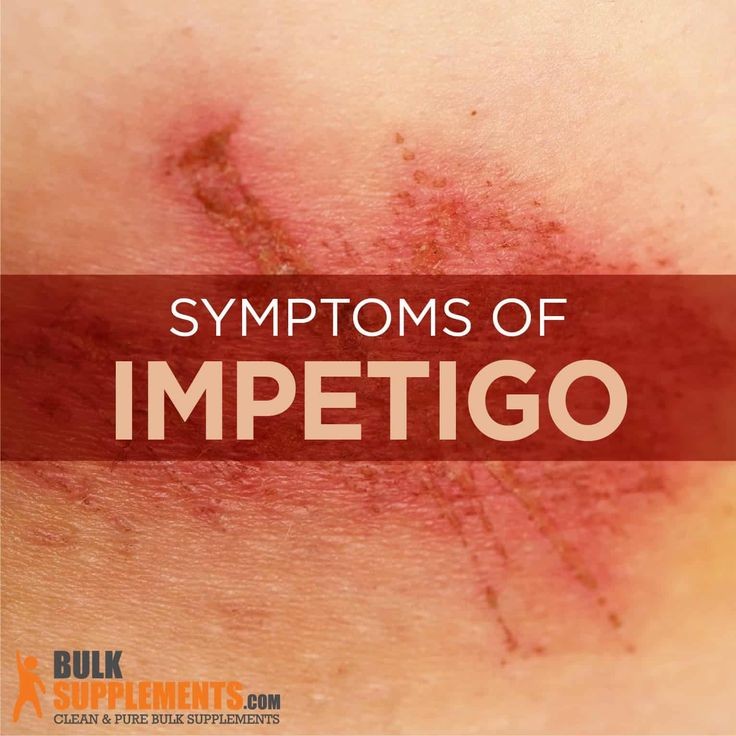
Contents
- 1 Impetigo
- 1.0.1 What causes impetigo?
- 1.0.2 What are the signs and symptoms of impetigo?
- 1.0.3 Is impetigo contagious?
- 1.0.4 What types of specialists diagnose and treat impetigo?
- 1.0.5 What tests and procedures diagnose impetigo?
- 1.0.6 What antibiotics treat impetigo?
- 1.0.7 What are the complications and prognosis of impetigo?
- 1.0.8 Will impetigo leave scars?
- 1.0.9 Can you prevent impetigo?
Impetigo
Impetigo is a bacterial skin infection more common in children than adults. The two types of impetigo are nonbullous and bullous impetigo.
What causes impetigo?
Impetigo is a contagious, superficial infection of the skin caused by Staphylococcus (staph) and Streptococcus (strep) bacteria.
- Impetigo is more common in children (especially 2- to 5-year-olds) than adults.
- Impetigo is likely to occur in warm and humid environments and is commonly spread by close contact (such as between family members).
Years ago, the formal name for this disease was "impetigo contageosum." A rarely used ecthyma is the term for a rash similar to impetigo, but the infection penetrates the skin more deeply (its therapy is similar to impetigo).
What are the signs and symptoms of impetigo?
Impetigo may manifest symptoms depending on the type of the disease, which may include:
- Nonbullous impetigo: This is the more common form, caused by both staph and strep bacteria.
- This form of impetigo initially manifests as small red bumps similar to insect bites.
- These contagious lesions rapidly evolve into small blisters and then into pustules that scab over with a characteristic honey-colored crust.
- This entire process usually takes about one week.
- These lesions often start around the nose and on the face, but less frequently affect the arms and legs.
- At times, non-tender but swollen lymph nodes (glands) may be nearby.
- Bullous impetigo: This form of impetigo is caused only by staph bacteria.
- These staph bacteria produce a toxin that reduces cell-to-cell stickiness (adhesion), causing separation between the top skin layer (epidermis) and the lower layer (dermis).
- This leads to the formation of a blister (the medical term for blister is bulla).
- Bullae can appear in various skin areas, especially the buttocks and trunk.
- These blisters contain a clear yellow-colored fluid and are fragile.
- The bullae often break with the overlying "roof" of skin lost, leaving red, raw skin with a ragged edge.
- A dark crust commonly develops during the final stages of development.
- The crust from impetigo resolves with healing.
Is impetigo contagious?
Impetigo is generally thought to be contagious during the first 24 hours of appropriate antibiotic therapy.
- If impetigo is caused by streptococci bacteria, it is contagious for about one to three days.
- If impetigo is caused by staphylococci bacteria, it is contagious for about four to 10 days.
Impetigo is primarily spread through direct contact with an infected person, but can also be transmitted through towels, toys, clothing, or household items. After starting in one location, impetigo often spreads to other parts of the body, especially in children.
- Mini epidemics of impetigo may occur in daycare centers.
- Bacteria that cause impetigo may enter through a break in the skin, such as cuts and scrapes.
- Heat, humidity, and the presence of eczema predispose a person to develop impetigo.
- Recurrent impetigo infections may be associated with staph or strep bacteria residing in the nose and spreading to other parts of the skin.
Impetigo is common in children aged 2-5 years old. Impetigo lesions often develop at the nasal openings inflamed by the prominent nasal drainage associated with a cold. In this situation, skin integrity is often disrupted by the continuous covering of purulent nasal discharge. Adults can also develop impetigo from close contact with infected children. A bandage should be applied to cover the infected area during this time.
The incubation period depends on the infective bacteria, with strep-caused impetigo having a shorter incubation period (one to three days) than staph-caused impetigo (four to 10 days).
What types of specialists diagnose and treat impetigo?
A primary care doctor, such as a pediatrician, family practice doctor, or internist, can manage the evaluation and treatment of impetigo. If there are unusual health issues or no response to appropriate antibiotic therapy, a specialist in infectious diseases could be consulted.
What tests and procedures diagnose impetigo?
Diagnosing an impetigo infection is generally straightforward and based on the clinical appearance. Occasionally, other conditions may resemble impetigo. Skin infections such as tinea ("ringworm") or scabies (mites) may be confused with impetigo. It is important to note that not every sore or blister indicates an impetigo infection. Other infected and noninfected skin diseases can produce blister-like skin inflammation. Such conditions include herpes cold sores, chickenpox, poison ivy, skin allergies, eczema, and insect bites.
Secondary skin infections may sometimes occur. Medical evaluation and occasionally culture tests are used to determine whether topical antibacterial creams will suffice or whether oral antibiotics will be necessary.
IMAGES
What antibiotics treat impetigo?
An impetigo infection is not serious and is easily treatable.
- Mild impetigo can be handled by gentle cleansing of the sores, removing crusts, and applying the prescription-strength antibiotic ointment mupirocin (Bactroban).
- Nonprescription topical antibiotic ointments (such as Neosporin) are generally ineffective.
- More severe or widespread impetigo, especially bullous impetigo, may require oral antibiotic medication. In recent years, more staph germs have developed resistance to standard antibiotics. Bacterial culture tests can help guide the use of proper oral therapy if needed.
- Helpful antibiotics include penicillin derivatives (such as amoxicillin-clavulanic acid [Augmentin]) and cephalosporins, such as cephalexin (Keflex).
- If other bacteria are identified through culture results, such as drug-resistant staph (methicillin-resistant Staphylococcus aureus or MRSA), other antibiotics such as clindamycin or trimethoprim-sulfamethoxazole (Bactrim or Septra) may be necessary.
Treatment is guided by laboratory results (culture and sensitivity tests).
What are the complications and prognosis of impetigo?
Complete cure and recovery of the infected area is anticipated when impetigo is treated, resulting in an excellent prognosis. A poor response to appropriate antibiotic therapy should raise concerns regarding the accuracy of the diagnosis, according to many specialists in infectious diseases.
A potentially serious but rare complication of impetigo caused by strep bacteria is glomerulonephritis, a condition that produces kidney inflammation. Many specialists are not convinced that treating impetigo will prevent glomerulonephritis from occurring.
Will impetigo leave scars?
Because the crusts and blisters of impetigo are superficial, impetigo generally does not leave scars. Affected skin looks red for a while after the crusts go away, but this redness fades within a matter of days to weeks. Once the skin has healed, sunscreen application is indicated.
Can you prevent impetigo?
Routine hand washing with soap and warm water is an important and effective way to prevent the spread of impetigo.
Paller, A.S., and A.J. Mancini. Hurwitz Clinical Pediatric Dermatology, 3rd Edition. London: Elsevier, 2006: 366-367.
Tessaro, Mark Oliver. "Visual Diagnosis: A Boy with a Fever and a Swollen, Blistering Finger." Pediatrics in Review 37.5 May 2016.
Tessaro, Mark Oliver. "Visual Diagnosis: A Boy with a Fever and a Swollen, Blistering Finger." Pediatrics in Review 37.5 May 2016.


